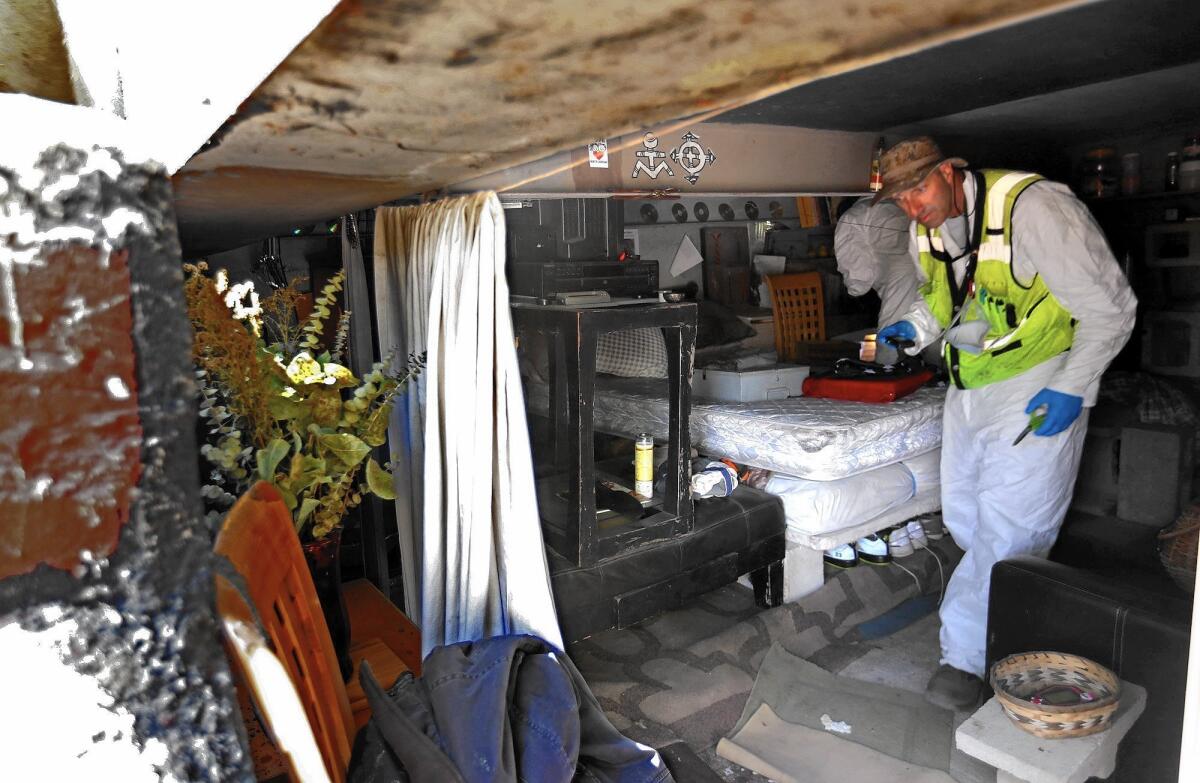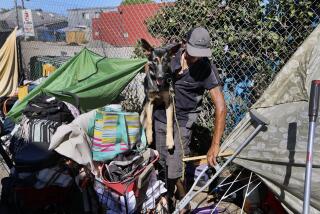As L.A. moves toward more homeless sweeps, long-term solution elusive

- Share via
The tents and tarpaulins were visible for miles, dotting the scrubby embankments of the Arroyo Seco and prompting complaints to the city from worried neighbors.
Many feared that the people living in the shaggy, freeway-adjacent tent cities were bringing drugs and petty crime into their northeast Los Angeles communities.
In May, the city launched a cleanup that took six days and cost $66,000 by the time it ended in late June, records show. But while the encampments along the concrete riverbed were cleared, none of the displaced people were given housing, advocates say. They simply scattered into the nearby streets of Lincoln Heights and Highland Park, or took to the hills of Elysian Park.
“They just moved them around,” said Monica Alcaraz, president of the Historic Highland Park Neighborhood Council.
The cleanup, which a city official said was permitted under existing law, offered a glimpse of how crackdowns on homeless camps could play out citywide under controversial new ordinances set to take effect July 18.
The two laws give homeless people 24 hours to remove their belongings from sidewalks and parks or face confiscation and citations or misdemeanor charges. The city has lost a string of court cases over removing homeless people and taking their property.
After legal setbacks, the city agreed to let homeless people sleep on the sidewalk, and to follow stricter protocols on seizing and storing their belongings. But facing a 12% surge this year in homeless numbers, and an explosion of camps far beyond skid row, the city is trying to give police officers more leeway to dismantle makeshift shelters and get homeless people to move along.
Business interests and homeowners support the measures, but advocates say clearing the streets doesn’t solve the problem if the homeless people have nowhere to go. Mayor Eric Garcetti has asked that the laws not be enforced until certain provisions are amended.
Officials said the people in the Arroyo were “service resistant” and turned down shelter beds and other aid. Rebecca Prine, director of the nonprofit Recycled Resources for the Homeless, said the Arroyo homeless people want housing in their own neighborhood — not on skid row or in South Los Angeles.
Prine said she and others, mostly volunteers, computer-matched about 150 homeless people in northeast Los Angeles to housing, including many who were pushed out of the Arroyo. But without staff, a car and other resources to help people obtain identification, get on welfare or Social Security and meet other prerequisites, the housing is on hold.
“It’s extraordinarily frustrating; they’re all sitting in the database,” said Prine, who wants the city to open a service access center in the northeast area. “The housing resources are there. What’s missing is the people to put it in motion.”
City Councilmen Jose Huizar and Gil Cedillo requested the cleanups. Huizar said the city could do “a better job” helping those in need but had a responsibility to “ensure that public areas are sanitary.”
“Homelessness is a complex problem,” Huizar said in a written statement. “It’s a countywide problem, and we require services and solutions available across the region.”
Cedillo opposed the new ordinances, which he described as a war on poor people. But he said that residents should not have to wait for homelessness to end to have a safe, clean environment.
“Their position is, ‘Look, I live there, I’m a taxpayer, I’m a voter, and you’re going to tell me a person is uncomfortable with a shelter and until I get another option, let them hang around your kid’s school?’” Cedillo said. “That’s not a plausible response for them.”
The Arroyo technically is off-limits to the public, but had long been a magnet for homeless people who broke down fences and set up camp, said Frank Mateljan, a spokesman for City Atty. Mike Feuer.
The city conducted periodic cleanups, but the camps would return, neighbors said. Mateljan said the Arroyo became a “nuisance,” with “criminal drug activity and hazardous waste” such as feces, syringes and flammable canisters.
As the operation wound down in late June, police and city workers confronted Veronica Gonzalez, 35, walking out of the Arroyo near the North Central Animal Shelter in Lincoln Heights.
Gonzalez had been told to leave the day before, but had returned. An outreach worker threatened Gonzalez with arrest if she didn’t take a shelter bed in South Los Angeles.
“She’s offering you some great options that you’ve never had,” LAPD Officer Austin Fernald told her. “I don’t want you arrested. I’d rather you get back on your feet.”
Gonzalez, blinking through thick false eyelashes, said she visits her three children every day at her mother’s Lincoln Heights home. “I don’t have bus money” to go to South L.A., she said.
“I don’t even know where that is,” she told the officers, pushing two shopping carts toward Avenue 26.
Farther down the riverbed, the cleanup crew tossed a bunker that Tom Stewart had outfitted for himself inside a block-wall enclosure at the base of a pedestrian bridge.
Police said families had complained that their kids saw a man bathing in public when they crossed the bridge to get to Florence Nightingale Middle School in Cypress Park.
Stewart, 45, said he’d been pushed out of two other northeast Los Angeles locations this year: Ernest E. Debs Regional Park and a large drain upriver known as “the cave.”
Workers yanked stuff out of Stewart’s dugout: chairs, bookcases, end tables, a sofa, footboard, a butane stove and a non-working fire extinguisher. His home decor included statuary, framed posters and a line of iridescent CDs spaced neatly on a ledge above his bed.
“One man’s trash is another man’s treasures,” said Officer Ulises Taveras of the Los Angeles Police Department.
At Stewart’s request, the crew handed him his cellphone, computer and wallet, but most of the property was declared hazardous waste and hauled down to dump trucks waiting in the concrete-lined channel.
“It helps when people are good-natured,” Stewart said as officers joked with him.
Stewart kept an anxious watch for an altar he used in his spiritual practice, which he described as a form of ancestor worship.
“I love my mama, I love my mama, I love my mama,” he said.
An officer carted a live 3-foot snake off the hillside. Workers finally found the plastic bag of sacred items and brought it out of the bunker.
With great effort holding the bag on his back, Stewart labored up the embankment to the street, where he hoped to find a cheap motel room for a few days.
“I’m used to being mistreated,” Stewart said.
[email protected]
Twitter: @geholland
More to Read
Sign up for Essential California
The most important California stories and recommendations in your inbox every morning.
You may occasionally receive promotional content from the Los Angeles Times.











